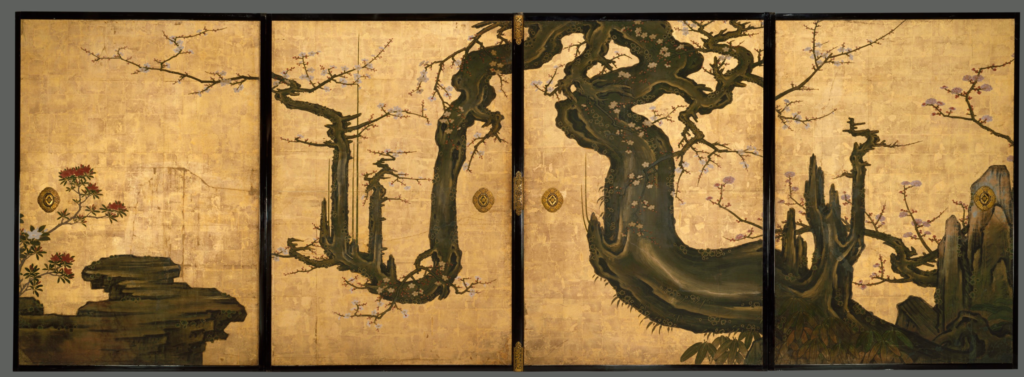
Four sliding door panels are very popular in Edo period Japan to not only decorate the home but tell a story from ancient traditions. In this specific panel, a large trunk of a plum tree spans nearly sixteen feet across all four slides. The plum tree represents springtime, rebirth, renewal, and new beginnings. These four panels, painted in 1646 were on the wall of a Zen temple in Kyoto (Tenshoin, a sub-temple of Myoshinji). The tree itself and the way that it is shaped is supposed to mimic the movement of a lizard moving throughout the panels. Trees being depicted as animal life is a common practice in Japanese storytelling with the idea that all nature is connected and works in harmony.
Title: Old Plum
Artist: Kano Sansetsu (Japanese, 1590–1651)
Period: Edo period (1615–1868)
Date: 1646
Culture: Japan
Medium: Four sliding-door panels (fusuma); ink, color, gold, and gold leaf on paper
Dimensions: Overall (of all four panels): 68 3/4 x 191 1/8 in. (174.6 x 485.5 cm)
Overall (a): 68 3/8 x 47 5/8 in. (173.7 x 121 cm)
Overall (b): 68 3/8 x 48 3/4 in. (173.7 x 123.8 cm)
Overall (c): 68 1/2 x 47 3/4 in. (174 x 121.3 cm)
Overall (d): 68 1/2 x 47 3/4 in. (174 x 121.3 cm)
Classification: Paintings
Credit Line: The Harry G. C. Packard Collection of Asian Art, Gift of Harry G. C. Packard, and Purchase, Fletcher, Rogers, Harris Brisbane Dick, and Louis V. Bell Funds, Joseph Pulitzer Bequest, and The Annenberg Fund Inc. Gift, 1975
Accession Number: 1975.268.48a–d